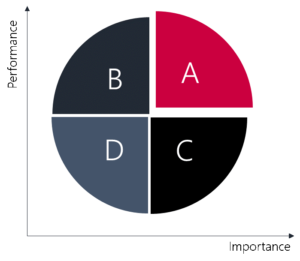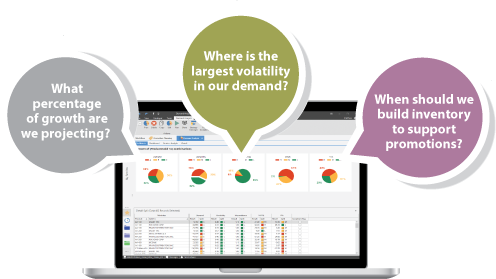
This Demand Segmentation Analysis Guide Covers:
What Demand Segmentation is
Product-Customer Demand Segmentation Methods
How Product-Customer Demand Segmentation Works
Phases of Demand Segmentation Analysis
Business processes have evolved over the past few decades. Back in the day, it was considered necessary for businesses to maintain an inventory of supplies. It helped businesses effectively meet the needs of Customers. As customers have become more demanding, and as the supply chains have become more complex, a key technique to effectively deal with this demand is the idea of demand segmentation.
What Is Demand Segmentation?

Sample demand segmentation categorization
Companies often organize their supply chains by market and production characteristics. For example, a demand related organization might rely on end users or market segments, whereas production related categorization might rely on an essential raw material or the use of particular equipment.
In the supply chain world, however, segmentation in demand planning requires a practice of a sort of divide and conquer scheme which is data based. This is commonly called demand segmentation.
Read More: Demand Management Best Practices
Demand Segmentation Definition
Demand segmentation is defined as the practice of analyzing demand data often divided into smaller sections (segments) to help measure performance or improve service levels.
Demand segmentation analysis can be performed on pre-defined company segments, including products or locations. Demand segmentation analysis is very effective when determining areas of improvement or analyzing a company’s key performance indicators (KPIs).
Product-Customer Demand Segmentation Methods
Arkieva Demand Analyzer
There are many useful approaches to segmenting your demand.
Here are some examples of how to approach your product-customer demand segmentation:
1. Key Performance Indicator (KPI) Segmentation Method
A KPI-based demand segmentation methodology involves using performance metrics to segment and analyze your demand. This is a very common point for getting started with your segmentation analysis.
Demand Segmentation KPI Examples:
- Volume: Which customers/products have the most volume?
- Order Count: Which customers/products have the most orders in the books?
- Revenue: Which customers/products give us the most revenue?
- Cost: Which customers/products are high/low Cost?
- Margin: Which customers/products have higher margins? Lower Margin? Negative Margin?
- Popularity: Which customers/products order/get ordered in every planning period?
- Trend: Which Customers/Products are increasing in volume? Decreasing in Volume?
- Order Lead Times: Which Customers/Products have long order lead times or long supply lead times?
- Fill Rate: Where are we doing a good job of supplying products to the customer?
- Inventory Levels: Where do we have too much? Too little?
- Aging Inventory: Where is the inventory at risk of obsolescence because it’s aging?
- Supply Difficulty: Where is the supply difficult? Takes long to make?
2. Lifecycle based demand Segmentation
Lifecycle based demand segmentation is a type of segmentation method where you segment your customer demand based on a product’s lifecycle. This type of segmentation method helps with managing your entire product lifecycle to ensure that you are forecasting demand accurately and paying attention to obsolete inventory.
In a lifecycle-based demand segmentation, you analyze the different product lifecycle stages of:
- New: new products that have just been introduced to the market
- Growing: products that are increasing in demand
- Steady: products that have a stable flow of demand but may have plateaued in this growth
- Slowing: products that have demand decreasing
- Dying: products that are starting to reach the matured lifecycle stage and might be moving into obsolesce soon
- Obsolete: Non-moving products that may represent dead inventory
3. Forecast-based Demand segmentation
In a forecast-based demand segmentation process, the goal is to analyze your demand to help improve forecast accuracy. Things to analyze or pay attention to include market trends, patterns, or forecast performance metrics.
In this process, you are looking to answer questions on customers/products such as:
- Which product demand shows a seasonal pattern?
- Which product demand shows a sporadic or intermittent pattern?
- Which product demand shows level shifts in demand (for instance, the product used to average 500/month; now they average 2000/month)?
- Which products have a High/Medium/Low CoV (Standard Deviation over mean)?
- Where do we have good forecast accuracy? Where is it poor?
The segmentation methodology that works best for your business will be dependent on your specific business goals and product types.
How Product-Customer Demand Segmentation Works
In product-driven Segmentation, you focus on the demand of any product.
Here’s how you can implement a product-driven demand segmentation process:
Analyze Demands
For any business, it’s crucial to identify and prioritize based on profitable Customers and outperforming products. For this purpose, you should perform Demand analysis and evaluate the costs involved with meeting those needs. You can start with a basic model that categorizes products based on current market shares and allocate the costs of ordering those products. You can further use this data to enhance the decision-making process.
Now that you’re better aware of customer demand, it’s time you develop a Segmentation strategy based on Demand signals such as Customer orders and Forecasts.
Optimize Inventory
Inventory is a major component of the Supply Chain that benefits from Segmentation. Through Segmentation, you can determine which products satisfy demand for a group of Customers. Inventory policies can be optimized if you clearly understand how certain products add value to your target audience.
Manage Customer Relationships
Managing Customer relationships is essential in Supply Chain Demand Segmentation. An organization can divide its Customers into different groups based on their profitability, services required, and distribution channels serving them. This type of segmentation can help businesses prioritize service levels in cases where there are production constraints. It can help determine when a make-to-order or make-to-stock strategy works best. For instance, for high volume products, a make-to-stock strategy might be ideal while low-volume product demand could be fulfilled with a make-to-order inventory strategy.
Manage Supplier Relationships
Just like it’s important to manage Customer relationships, you can’t overlook the importance of managing Supplier relationships when it comes to Demand Segmentation.
In Supplier replenishment programs, you must segment Suppliers based on component dynamics that align with business objectives. For example, you can segment Suppliers by combining multiple characteristics such as nearshore capacity with short lead times.
Phases of Demand Segmentation Analysis
As you approach your demand segmentation analysis process it’s important to understand some of the most prominent phases of the demand segmentation process.
Here are the most prominent phases of Demand Segmentation:
- Intelligence Phase – It includes a detailed analysis based on performance indicators and the identification of order qualifiers and winners and relevant Segmentation variables
- Design Phase – In this phase, strategic priorities are allocated to each Supply Chain Demand segment
- Choice Phase – It includes the evaluation of feasibility, consistency, and agreement of Supply Chain Segmentation
- Implementation Phase – In this phase, the Supply Chain department prepares for implementation, reconfigures Supply Chain processes, and monitors and controls standard practices.
In today’s world, Customers are more empowered than ever before. Increasing customer delight involves letting go of a one-size-fits-all approach. The methodologies listed above are great starting point for as you embark on your demand segmentation process or re-evaluate your existing strategy. Once you have these foundational segmentation processes in place, you can move on to a more complex analysis of combining segments to help you answer more detailed questions about your demand. We’ll cover that in a later blog.
Ready to get started? Ask for a demo of the Arkieva Demand Analyzer.







